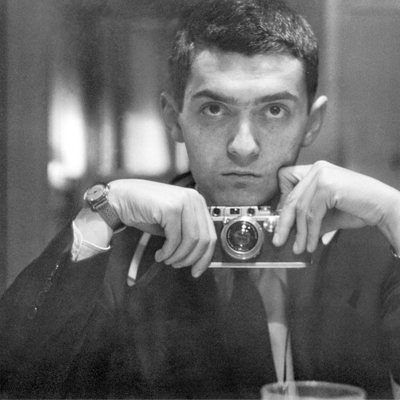
Considered one of the most innovative, daring and independent filmmakers to come out of the post-World War II generation, Stanley Kubrick inspired many of our current motion picture auteurs, such as Steven Spielberg (whose film "A.I: Artificial Intelligence" was originally a Kubrick production), Martin Scorsese (who owns several original Kubrick 35mm prints in his exhaustive film library) and CMU Alumnus George A. Romero (who cited Kubrick's "Dr. Strangelove: Or How I Learned to Stop Worrying and Love the Bomb" as one of his top ten films of all time).
His iconic, metaphysical science fiction film "2001: A Space Odyssey" was so groundbreaking in its use of special photographic effects, he was awarded a Special Visual Effects Oscar in 1969, the only Academy Award he would ever receive. But everyone has to start somewhere and the road to greatness, particularly in film, can have several detours. Kubrick's first feature "Fear and Desire" - available on the libraries' Kanopy Streaming Video service - while not a successful film in this author's opinion, still serves as a testament to the learning process and displays the raw talent that was to blossom in Kubrick's future films.
At the time of "Fear and Desire's" production, the 25-year-old Kubrick had already displayed remarkable skill in both still photography and documentary filmmaking. While an average student in school, Kubrick's ferocious appetite for self-education made him adept at several subjects such as chess and military history; lifelong passions that he would continue to study. But movies became his main thrust, and without access to traditional gateways into this profession, Kubrick had to segue into more creative and independent alternatives in order to achieve his goal of making a narrative feature film. While working as a staff photographer for Look magazine, he produced "The Day of the Fight" and "Flying Padre," two short documentary films which Kubrick directed, photographed and edited. Already adept at capturing the reality of his subjects though still photography, creating documentary films was a natural progression, and one that Kubrick felt was a valuable education. When the time came for Kubrick to film "Fear and Desire," he was ready to put his new-found abilities to the test.
Produced on an original budget of $10,000 (raised through Kubrick's family and friends), "Fear and Desire" tells the story of a group of soldiers who are lost behind enemy lines in an unnamed country, and the drama that ensues as they attempt escape. As with his documentary shorts, Kubrick once again served as director, producer, cinematographer, editor and sound designer. Unlike his documentary films however, which encouraged a level of spontaneity and experimentation, Kubrick was forced to learn and work within the technical confines of a narrative feature; skills he had not yet mastered. This includes stage direction, the 180-degree rule and film editing techniques to convey movement and coverage. Much of this is lacking in "Fear and Desire," which can create a jarring film experience, especially for modern day viewers. In one sequence, Kubrick blocked a scene incorrectly causing the actor to enter from the wrong side of the frame. This mistake wasn't noticed until the editing phase of production, and he was forced to flip the negative during the printing process at his own added expense.
Released in 1953 to uneven reviews - though many noted critics such as James Agee praised the film - "Fear and Desire" was a box-office disappointment that forced Kubrick to take paid commissioned work in order to recoup his costs and raise funds for his next feature "Killer's Kiss." Kubrick himself was embarrassed by the film, calling it 'a bumbling amateur film exercise' and even attempted to pull it from later distribution (the only commercially available print is brought to us through Kanopy by the George Eastman House). But to describe "Fear and Desire" as a failure is unfair. Within its rough presentation, the hallmarks of Kubrick's genius can still be seen, such as his fascination with the military - which he would explore again in "Paths of Glory," "Dr. Strangelove" and "Full Metal Jacket" - his use of photographic composition and lighting and the themes of inner struggle he would infuse in all of his main characters moving forward. While by no means his best work, "Fear and Desire" is still an example of an artist unafraid to fail; a lesson that all of our students, particularly those in the upcoming film and media studies major at CMU, should learn from as they progress in their studies. There should be no shame in trial and error, and as Kubrick himself would later declare, 'The best education in film is to make one.'
Learn more about Stanley Kubrick by viewing this saved search in our library catalog, and contact Jeff Hinkelman (jh51@andrew.cmu.edu) to view his films in our video collection!
By Andy Prisbylla, Library Programming and Engagement Coordinator
